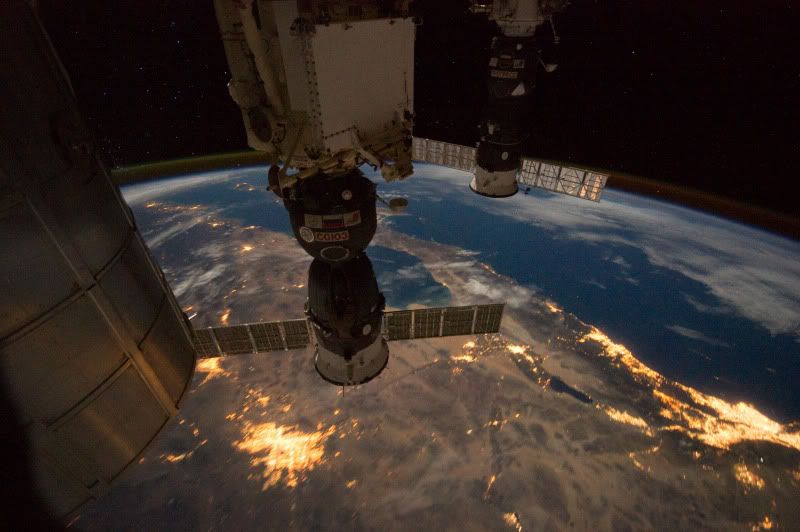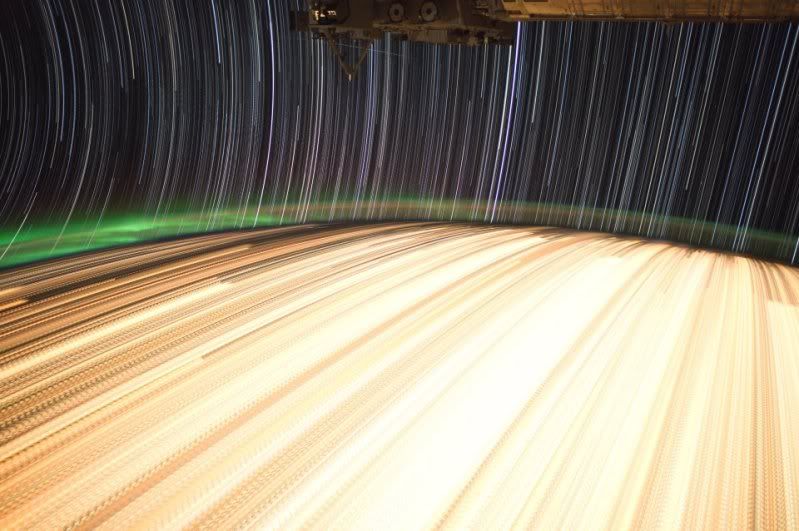Yesterday I shared this picture on Facebook & via Twitter:
I guess it made at least somewhat of a splash because it ended up today in the San Diego Union Tribune newspaper. My point was to show the city lights as a discussion point for light pollution, energy waste, etc. No mention of that made it into the paper, although the reporter did point out that I work for the International Dark-Sky Association.
For those who do not recognize the scene below the International Space Station, the coastlines of southwest California and Baja Mexico are visible as well as (from left to right along the coast) the city lights of Tijuana, San Diego and Orange County. The big city well inland is Phoenix, AZ (South is left of up in this view).
Here is another view that covers some of the same geography, but looking almost 180 degrees in a different direction and without the ISS taking up so much of the frame:
This time the Sea of Cortez is in the lower center, with Baja and the lights of the California cities on the left (North is left of up). Also visible inland (from left to right) are Las Vegas, Phoenix and Tucson. Here's an annotated version to help you find them:
You probably already know the answer to this, but which of these cities have lighting controls? Notice that the lights of Las Vegas look white - they have saturated that portion of the camera's electronic detector. Like everything in Las Vegas, its lights are also famous for being over the top. The light polluting sky glow produced there is visible from hundreds of miles away and proves that what is illuminated in Vegas does not stay there.
The brightest city in Arizona, Phoenix, is bigger than Las Vegas. While it is a very large source of light pollution, notice that its core is not a intensely illuminated as that of Vegas. Tucson is certainly bigger than Vegas, but it is much dimmer. That's the result light pollution controls put in place there. The latest revision of Tucson/Pima County Outdoor Lighting Code was put in place just last week and should help to keep Southern Arizona friendly for astronomy for some time to come.
Can you spot Flagstaff? It became the world's first International Dark-Sky City in 2001. It is smaller than Tucson and has even tighter lighting controls. I believe that you'll find it just to the left of the "P" in Phoenix.
Coming back to California, can you tell which cities have lighting controls? Look at the LA & San Diego areas. There is a difference.
Sunday, March 18, 2012
Saturday, March 17, 2012
Help End the Waste of Light Pollution
The standard technique in the digital age to take star trail photos is to take a series of still photos and then combine them into one single image like this one:
The resulting image is a dramatic view that shows stars trailing across the image as a result of Earth's rotation. Polaris (aka "the North Star") is the nearly stationary star near the upper left. In this shot the telescope dome also moved several times giving it an odd look.
I used StarStaX to combine the images. It is a free program for the Mac that is very easy to use and gives great results.
If you have been reading this blog you know I have been spending a fair amount of time looking at the remarkable photography coming from the International Space Station (ISS) - the astronauts have been taking images of Earth and its cities from their vantage point in space.
The resulting movies, like the one linked in my last post, vividly show off their view from on high and that the glow of city lights can easily be seen from space. Since the individual frames for the movies are available, I decided to try some "star trail photography" using the images from the ISS. The result was this jaw-dropping image:
The shot was produced by adding some 900 frames taken as the astronauts passed from SW Texas to New Brunswick, Canada. It vividly shows that, even from space, the lights of our cities are dramatically brighter than the stars. The city lights form bright streaks across the view. They are the result of poorly directed light, a waste of energy almost too large to comprehend.
Next, I created a time-lapse movie from the images, stuck on the original movie and gave it a bit of narration. Here's the result:
The problem of light pollution is not unique to North America. This view of the European Union shows that continental Europe also has a lot of work to do in switching to more environmentally-friendly lighting.
It doesn't have to be this way. The International Dark-Sky Association is working to end light pollution, but your help is needed. By joining the IDA you can contribute to the cause and help the environment by cutting energy waste, greenhouse gas emissions and sky glow. This can all be done by using responsible lighting that still provides for safety and security while limiting light pollution.
The resulting image is a dramatic view that shows stars trailing across the image as a result of Earth's rotation. Polaris (aka "the North Star") is the nearly stationary star near the upper left. In this shot the telescope dome also moved several times giving it an odd look.
I used StarStaX to combine the images. It is a free program for the Mac that is very easy to use and gives great results.
If you have been reading this blog you know I have been spending a fair amount of time looking at the remarkable photography coming from the International Space Station (ISS) - the astronauts have been taking images of Earth and its cities from their vantage point in space.
The resulting movies, like the one linked in my last post, vividly show off their view from on high and that the glow of city lights can easily be seen from space. Since the individual frames for the movies are available, I decided to try some "star trail photography" using the images from the ISS. The result was this jaw-dropping image:
The shot was produced by adding some 900 frames taken as the astronauts passed from SW Texas to New Brunswick, Canada. It vividly shows that, even from space, the lights of our cities are dramatically brighter than the stars. The city lights form bright streaks across the view. They are the result of poorly directed light, a waste of energy almost too large to comprehend.
Next, I created a time-lapse movie from the images, stuck on the original movie and gave it a bit of narration. Here's the result:
The problem of light pollution is not unique to North America. This view of the European Union shows that continental Europe also has a lot of work to do in switching to more environmentally-friendly lighting.
It doesn't have to be this way. The International Dark-Sky Association is working to end light pollution, but your help is needed. By joining the IDA you can contribute to the cause and help the environment by cutting energy waste, greenhouse gas emissions and sky glow. This can all be done by using responsible lighting that still provides for safety and security while limiting light pollution.
Subscribe to:
Posts (Atom)





